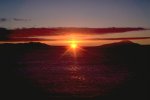 |
 |
 |
 |
 |
 |
 |
Signs of Spring Everywhere Update: March 1, 1999
Today's Report Includes:
- Lighten Up!
- Just Duckie
- Duck Watching Tips for This Week
- Challenge Question # 4
- Observation from the Past
- How to Respond to This Week's Challenge Question
Lighten Up!
 In the middle of winter, newspaper carriers in Duluth, Minnesota (47.11, -91.85),
work in the dark. Papers have to be delivered by 6:30 am, so carriers are outside by 5:45 or 6:00. In the past
few weeks, they've been noticing the sky brightening by the time they finish, and now it's bright in the east by
the time they start out. Sunrise today, March 1, 1999, is at 6:49 am in Duluth, so unless papers are late, carriers
don't see the actual sunrise yet, but in a couple of weeks they'll be seeing the sun come up as they deliver papers.
In the middle of winter, newspaper carriers in Duluth, Minnesota (47.11, -91.85),
work in the dark. Papers have to be delivered by 6:30 am, so carriers are outside by 5:45 or 6:00. In the past
few weeks, they've been noticing the sky brightening by the time they finish, and now it's bright in the east by
the time they start out. Sunrise today, March 1, 1999, is at 6:49 am in Duluth, so unless papers are late, carriers
don't see the actual sunrise yet, but in a couple of weeks they'll be seeing the sun come up as they deliver papers.What time is sunrise where you live? What day this month will your city have the exact same length of day as Duluth, Minnesota? (If you don't know when sunrise or sunset are where you live, you can find out here: worldwide sunrise times US sunrise times.) To learn more about how light affects animals, try Journey North's Seeing the Light lesson, also in the printed Teacher's Manual on page 93.
Just Duckie
Birds don't deliver papers, but they also detect changes in daylight. Right now ducks are starting their journey north. Throughout the continent, birders are reporting the new arrivals. Wally Jobman is Journey North's correspondent from the Platte River of Nebraska, right smack in the center of things. He wrote, "As usual there were many overwintering Mallards along the Platte River, especially since it was an "open" winter without much ice or snow cover. Many pintails, shovelers, and teal are presently migrating across Nebraska. From my few observations, numbers appear to be normal."
Duck Watching Tips for This Week:
- How many different species can you find?
- How many are alone, how many in pairs, how many in small groups, and how many in flocks?
- Are all the ducks in the water? Can you find any ducks in other places?
- Virtually all ducks are in their adult plumage now, so count males and females.
Usually our counts show more males than females. When nesting begins, that difference will get much bigger.
Which leads us to this week's:
Challenge Question #4
"Name at least two different reasons why we usually count more male than female ducks in spring."
(To repond to this question, please follow
the instructions below.)
Neotropical migrants have no idea what the weather will be like on the other side of the Gulf of Mexico when they
strike out. They time their migration by daylength. But many ducks spent their winter in North America. Their migratory
restlessness seems to develop as a combination of opening water and increasing daylength. It can be tricky for
us to figure out which individual ducks arrived from farther south and which were nearby all winter, but we CAN
watch one sure sign of spring. At the same time that they're migrating, drakes (male ducks) that don't already
have a mate are trying to attract one. It's fun watching drakes try to get the attention of hens. Some use bright
feathers and noisy quacks to impress females, but one, the Common Goldeneye, has a spectacular mating display.
Observation from the Past
|
Photo: Dave Rintoul, Patuxent Bird ID Info Center |
How to Respond to Today's Challenge Question
1.Address an e-mail message to: jn-challenge-spring@learner.org
2. In the Subject Line of your message write: Challenge Question # 4
3. In the body of your message, answer the question.
The Next Signs of Spring Update Will be Posted on March 15, 1999
Copyright 1999 Journey North. All Rights Reserved. Please send all questions, comments, and suggestions to our feedback form
 |
 |
 |
 |
 |
 |

